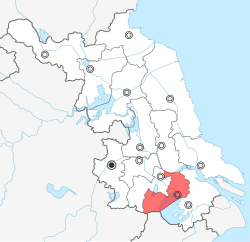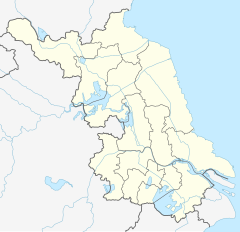
A | B | C | D | E | F | G | H | CH | I | J | K | L | M | N | O | P | Q | R | S | T | U | V | W | X | Y | Z | 0 | 1 | 2 | 3 | 4 | 5 | 6 | 7 | 8 | 9
This article has multiple issues. Please help improve it or discuss these issues on the talk page. (Learn how and when to remove these template messages)
|
Wuxi
无锡市 Wusih, Wuhsi | |||||||||||||||||||||||||||||||||||||||||||||||||||||||
|---|---|---|---|---|---|---|---|---|---|---|---|---|---|---|---|---|---|---|---|---|---|---|---|---|---|---|---|---|---|---|---|---|---|---|---|---|---|---|---|---|---|---|---|---|---|---|---|---|---|---|---|---|---|---|---|
SanYang Palza TaiLake New City Tai Lake YuanTouZhu Jichang Royal Garden Qingming Bridge Cultural Block Downtown Wuxi | |||||||||||||||||||||||||||||||||||||||||||||||||||||||
| Motto(s): Wuxi is full of warmth and water | |||||||||||||||||||||||||||||||||||||||||||||||||||||||
 | |||||||||||||||||||||||||||||||||||||||||||||||||||||||
 Location in Jiangsu | |||||||||||||||||||||||||||||||||||||||||||||||||||||||
| Coordinates (Chengzhong Park (城中公园, CBD)): 31°29′28″N 120°18′43″E / 31.491°N 120.312°E | |||||||||||||||||||||||||||||||||||||||||||||||||||||||
| |||||||||||||||||||||||||||||||||||||||||||||||||||||||
| Wuxi | |||||||||||||||||||||||||||||||||||||
|---|---|---|---|---|---|---|---|---|---|---|---|---|---|---|---|---|---|---|---|---|---|---|---|---|---|---|---|---|---|---|---|---|---|---|---|---|---|
 "Wuxi" in Simplified (top) and Traditional (bottom) Chinese characters | |||||||||||||||||||||||||||||||||||||
| Simplified Chinese | 无锡 | ||||||||||||||||||||||||||||||||||||
| Traditional Chinese | 無錫 | ||||||||||||||||||||||||||||||||||||
| Hanyu Pinyin | PRC Standard Mandarin: Wúxī ROC Standard Mandarin: Wúxí | ||||||||||||||||||||||||||||||||||||
| |||||||||||||||||||||||||||||||||||||
Wuxi (Chinese: 无锡, WOO-shee) is a city in southern Jiangsu province, eastern China. As of the 2020 census, the city had a total population of 7,462,135 inhabitants.
Wuxi borders Suzhou City to the east, 128.2 kilometers away from Shanghai; borders the Yangtze River to the north, across the river from Jingjiang City under the jurisdiction of Taizhou City; borders Taihu Lake to the south, bordering Zhejiang Province; borders Changzhou City to the west, 183 kilometers away from Nanjing. Wuxi is known as the "Pearl of Taihu Lake" and is one of the core cities in the Yangtze River Delta and the Suzhou-Wuxi-Changzhou Metropolitan Area. The municipal government is located at No. 1 Jingui Road, Taihu New Town.
Wuxi is the birthplace of Jiangnan civilization and the birthplace of Wu culture. Its recorded history can be traced back to the late Shang Dynasty. In 1981, the State Council listed Wuxi as one of the fifteen economic center cities in the country. It was also one of the first 13 larger cities approved by the State Council and enjoyed local legislative power. At the same time, Wuxi is also a famous historical and cultural city in the People's Republic of China. In 1998, it was rated as one of the first batch of outstanding tourist cities by the National Tourism Administration. In March 1983, the city-governed county system was implemented. Wuxi County and Jiangyin County, which were originally in the Suzhou area, and Yixing County, which was originally in the Zhenjiang area, were placed under the jurisdiction of Wuxi City, establishing the structure of Wuxi City as one body and two wings. Wuxi is currently one of the central cities in the Shanghai metropolitan area and the Suzhou-Wuxi-Changzhou metropolitan area. It is also the cradle of China's national industry and township industry, the birthplace of the southern Jiangsu model, and the location of the Wuxi Joint Logistics Support Center of the joint logistics support force.
Wuxi is an important scenic tourist city in the country and a national historical and cultural city. Within the city, there are Taihu Lake Yuantouzhu, Lingshan Giant Buddha, Nianhua Bay, Wuxi China Television Film and Television Base, Lihu Park, Chong'an Temple, Huishan Ancient Town, Xihui Scenic Area and other scenic spots. Wuxi is known as the cloth wharf, money wharf, kiln wharf, silk capital and rice market. Currently, Wuxi has landmark industries such as the Internet of Things, integrated circuits, and biomedicine; in addition, Wuxi has convenient transportation, with the Beijing-Shanghai Expressway, Shanghai-Nanjing Urban Railway, and Beijing-Shanghai High-speed Railway passing through it. As of 2024, Wuxi Metro, the urban rail transit system, will operate The mileage is 145 kilometers; there is 4E-class Sunan Shuofang International Airport in the southeast of the city. While achieving economic development achievements, Wuxi is also accompanied by cultural soft power. Many celebrities have emerged from Wuxi, such as Gu Kaizhi, Ni Yunlin, Qian Mu, Qian Zhongshu, etc., as well as ancient and modern celebrities represented by Jichang Garden, Liyuan, Yuantouzhu, etc. Famous gardens are handed down from generation to generation.
Etymology
Despite varied origin stories based on the second Chinese character 锡 of the city's name meaning "tin", many modern Chinese scholars favor the view that the word is derived from the "old Yue language" or, supposedly, the old Kra–Dai languages, rather than reflecting the presence of tin in the area.[3][4][5]
History
Clues are to be found at the Meili Museum and the Helv Relics Museum, Wuxi is the ancient capital of Wu State during the Spring and Autumn Period (770-476 BCE).[6] Taibo and Zhongyong traveled southeast and settled in Wuxi Meili. There, Taibo and his followers set up the State of Wu, and made Wuxi as its founding capital which lasted for 600 years. The history of Wuxi can be traced back to Shang dynasty (1600–1046 BC).[7] The tin industry thrived in the area in ancient times but it was eventually depleted, so that when Wuxi was established in 202 BCE during the Han dynasty, it was named "Wuxi" (the capital of WU state). Administratively, Wuxi became a district of Biling (later Changzhou) and only during the Yuan dynasty (1206–1368) did it become an independent prefecture.[8] Wuxi and Changzhou are considered to be the birthplaces of modern industrialization in China.[9]
Agriculture and the silk industry flourished in Wuxi and the town became a transportation hub under the early Tang Dynasty after the opening of the Grand Canal in 609. It became known as one of the biggest markets for rice in China.[8]
The Donglin Academy, originally founded during the Song dynasty (960–1279) was restored in Wuxi in 1604. Not a school, it served as a public forum, advocating a Confucian orthodoxy and ethics. Many of its academicians were retired court officials or officials deposed in the 1590s due to factionalism.[10]
As a populous county, its eastern part was separated and made into Jinkui county in 1724. Both Wuxi and Jinkui were utterly devastated by the Taiping Rebellion, which resulted in nearly 2/3 of their population being killed.[11] The number of "able-bodied males" (ding, 丁) were only 72,053 and 138,008 individuals in 1865, versus 339,549 and 258,934 in 1830.[12]
During the Qing dynasty (1644–1912), cotton and silk production flourished in Wuxi.[13] Trade increased with the opening of ports to Shanghai in 1842, and Zhenjiang and Nanjing in 1858. Wuxi became a center of the textile industry in China. Textile mills were built in 1894 and silk reeling establishments known as "filatures" were built in 1904.[8] Wuxi was remained the regional center for the waterborne transport of grain. The opening of the railways to Shanghai and to the cities of Zhenjiang and Nanjing to the northwest in 1908 further increased the exports of rice from the area.[8] Jinkui xian merged into Wuxi County with the onset of the Republic in 1912.[14] Many agricultural laborers and merchants moved to Shanghai in the late 19th century and early 20th century; some prospered in the new factories.[9]
After World War II, Wuxi's importance as an economic center diminished, but it remains a regional manufacturing hub. Tourism has increasingly become important.[8] On April 23, 1949, Wuxi was divided into Wuxi City and Wuxi County, and it became a provincial city in 1953 when Jiangsu Province was founded. In March 1995, several administrative changes were made within Wuxi City and Wuxi County to accommodate for Wuxi New District, with the creation of 19 administrative villages such as Shuofang, Fangqian, Xin'an and Meicun.[7] Jiangnan University was originally founded in 1902, before merging with two other colleges in 2001 to form the modern university.[15]
Climate
| Climate data for Wuxi (1991–2020 normals, extremes 1981–2010) | |||||||||||||
|---|---|---|---|---|---|---|---|---|---|---|---|---|---|
| Month | Jan | Feb | Mar | Apr | May | Jun | Jul | Aug | Sep | Oct | Nov | Dec | Year |
| Record high °C (°F) | 22.1 (71.8) |
26.8 (80.2) |
29.1 (84.4) |
34.8 (94.6) |
35.3 (95.5) |
38.1 (100.6) |
39.7 (103.5) |
40.1 (104.2) |
37.5 (99.5) |
33.1 (91.6) |
28.7 (83.7) |
22.5 (72.5) |
40.1 (104.2) |
| Mean daily maximum °C (°F) | 7.8 (46.0) |
10.2 (50.4) |
14.9 (58.8) |
21.0 (69.8) |
26.2 (79.2) |
28.9 (84.0) |
32.8 (91.0) |
32.3 (90.1) |
28.2 (82.8) |
23.1 (73.6) |
17.2 (63.0) |
10.6 (51.1) |
21.1 (70.0) |
| Daily mean °C (°F) | 3.9 (39.0) |
6.0 (42.8) |
10.2 (50.4) |
16.0 (60.8) |
21.4 (70.5) |
24.9 (76.8) |
28.9 (84.0) |
28.3 (82.9) |
24.2 (75.6) |
18.6 (65.5) |
12.6 (54.7) |
6.3 (43.3) |
16.8 (62.2) |
| Mean daily minimum °C (°F) | 0.9 (33.6) |
2.6 (36.7) |
6.4 (43.5) |
11.7 (53.1) |
17.2 (63.0) |
21.6 (70.9) |
25.7 (78.3) |
25.3 (77.5) |
20.9 (69.6) |
14.9 (58.8) |
8.9 (48.0) |
2.9 (37.2) |
13.3 (55.9) |
| Record low °C (°F) | −9.2 (15.4) |
−7.6 (18.3) |
−3.5 (25.7) |
0.7 (33.3) |
8.7 (47.7) |
11.6 (52.9) |
18.4 (65.1) |
18.3 (64.9) |
11.7 (53.1) |
2.8 (37.0) |
−3.2 (26.2) |
−8.0 (17.6) |
−9.2 (15.4) |
| Average precipitation mm (inches) | 66.3 (2.61) |
61.7 (2.43) |
83.6 (3.29) |
84.5 (3.33) |
95.4 (3.76) |
210.6 (8.29) |
180.8 (7.12) |
173.9 (6.85) |
92.1 (3.63) |
58.4 (2.30) |
59.3 (2.33) |
40.8 (1.61) |
1,207.4 (47.55) |
| Average precipitation days (≥ 0.1 mm) | 10.2 | 9.9 | 11.4 | 10.5 | 11.2 | 13.3 | 12.1 | 12.6 | 8.8 | 7.9 | 8.5 | 7.7 | 124.1 |
| Average snowy days | 3.0 | 2.0 | 0.8 | 0.1 | 0 | 0 | 0 | 0 | 0 | 0 | 0.2 | 0.9 | 7 |
| Average relative humidity (%) | 74 | 74 | 71 | 70 | 70 | 77 | 77 | 78 | 77 | 74 | 75 | 72 | 74 |
| Mean monthly sunshine hours | 123.0 | 124.0 | 145.8 | 171.0 | 181.4 | 136.7 | 189.5 | 185.4 | 161.9 | 162.4 | 140.3 | 139.0 | 1,860.4 |
| Percent possible sunshine | 38 | 40 | 39 | 44 | 43 | 32 | 44 | 46 | 44 | 47 | 45 | 45 | 42 |
| Source: China Meteorological Administration[16][17] | |||||||||||||
Administrative Divisions
The prefecture-level city of Wuxi administers seven county-level divisions, including 5 districts and 2 county-level cities. The information here presented uses the metric system and data from the 2020 Census.
These districts are sub-divided into 73 township-level divisions, including 59 towns and 24 subdistricts.











